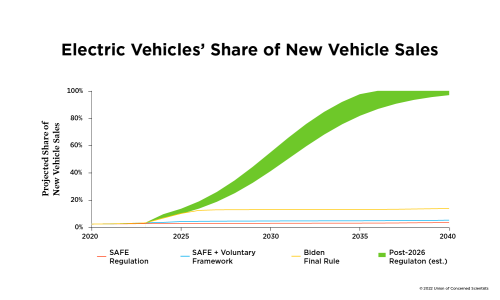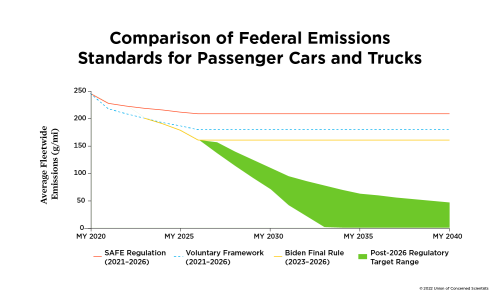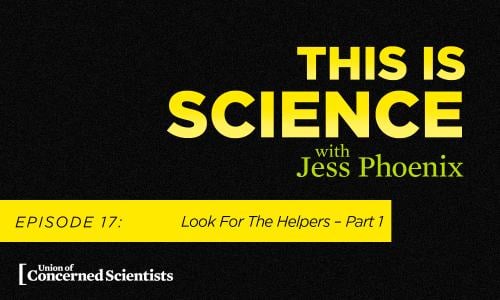The Biden administration’s new standards for fuel economy and global warming emissions help put the car industry back on a path toward addressing climate change, undoing much of the previous administration’s damage.
The new targets will drive improvements in the efficiency of gasoline-powered vehicles while pushing the industry to deploy electric vehicles. However, gasoline-powered vehicles would continue to dominate new vehicle sales under these rules. Economic and climate modeling shows that all new vehicle sales must be electric by 2035 to prevent the worst impacts of global warming. The administration must move quickly to set a new round of standards for model years 2027 and beyond, charting the course to a fully electric passenger vehicle market.
Electrifying Standards for New Passenger Cars and Trucks
This is a condensed, online version of the report. Access to all figures and full report are available through download of the PDF.
Ten years ago, the Obama administration set strong standards for global warming emissions and fuel economy for new passenger cars and trucks, aiming to double efficiency by model year (MY) 2025 (EPA and NHTSA 2012). However, when a new administration took office in 2016, automakers seized the moment to lobby hard for rolling back those standards. In 2020, they succeeded when the Environmental Protection Agency (EPA) and the National Highway Traffic Safety Administration (NHTSA) finalized the so-called Safer Affordable Fuel-Efficient (SAFE) Vehicles Rule, reducing standards for the 2021–2025 model years and setting a final target for MY 2026 consistent with the pre-rollback target for MY 2023 (EPA and NHTSA 2020). The retreat was not only unlawful; it lacked technical justification, was riddled with errors, and was net detrimental to public health and welfare even by the EPA’s own analysis (Cooke 2020).
Moreover, with the SAFE rule, the EPA and NHTSA attempted to strip away states’ ability to set their own, presumably stricter, emissions standards (EPA and NHTSA 2019). Indeed, the tenuous justification of the SAFE rule and California’s long-standing authority to set emissions standards equal to or stronger than federal requirements led to uncertainty in the industry. As a result, five automakers,1 making up about 30 percent of total US sales, signed voluntary agreements with California to achieve emissions reductions nationwide that well exceeded the federal requirements.
Upon entering office, President Biden immediately issued an executive order to reevaluate the harmful SAFE rule, calling for the EPA and NHTSA to “listen to the science” and “immediately commence work to confront the climate crisis” (Exec. Order No. 13990). These new rules do just that, yet the back-and-forth agency actions show just how critical it is to address climate change through robust, scientifically driven regulations that provide the certainty needed for investments. This is why the Biden administration must follow up with even stronger, longer-term regulations that put the automobile industry on a sustainable, robust trajectory toward eliminating tailpipe emissions by going to a fully electric passenger vehicle market.
Getting Back in the Right Lane
- While stronger than the SAFE rule, the voluntary agreements with California still offered automakers a number of harmful “flexibilities.” Specifically, they eroded some required reductions by awarding credits in ways that were not commensurate with the real-world benefits of the vehicle technologies:
- “Electric Vehicle (EV) multipliers” treat the sale of an EV2 as more than one vehicle for compliance purposes (up to 2X) (Cooke 2021a).
- Automakers could earn extra credits for selling hybrid pickup trucks (Cooke 2021b).
- Manufacturers could earn an increasing number of credits for so-called “off-cycle” technologies whose “benefits” are not captured by standard test procedures, despite questionable evidence that such technologies actually reduce emissions in the real world (Cooke 2021c).
The EPA initially proposed to use the voluntary agreements as a template for its own emissions regulations, incorporating these compliance flexibilities in MY 2023 and setting an initial regulatory target comparable to that required under those agreements. When the resulting proposed rule was weaker than it could have been, a combination of grassroots and expert advocacy, along with pressure from the White House, made a difference. The final rule reduces the EV multipliers and caps them well below the level of the voluntary agreements. Moreover, after MY 2024, the final rule eliminates both the multipliers and the credits for hybrid pickup trucks.
Requirements for reductions in fleet average global warming emissions under the new rules rise from 5 percent per year up to 10 percent by MY 2026. This is significantly better than the SAFE rule, but the rate of improvement will need to continue to accelerate in order to meet climate targets (Figure 1).
Reducing Emissions and Electrifying the Future
The targets for MY 2026—the strongest ever—set a solid path forward for the auto industry. They yield tremendous benefits from reduced pollution, reduced fuel use, and reduced global warming emissions (Box 1). Perhaps most important, the new standards put the industry back on track toward a more sustainable future: UCS modeling projects 14 percent EV deployment by the end of the rule in MY 2026 (Figure 2). Setting even stronger standards for MY 2027 and beyond would further accelerate EV deployment.
Going Further
New vehicles are more efficient than ever before, and the recently finalized standards will continue to push the industry. That said, several continuing loopholes threaten the efficacy of the new rules. As the Biden administration seeks to deal with the climate crisis, future standards must be even more robust to maximize all available emissions reductions.
The SUV Loophole
Since the nation first set standards for global warming emissions, new vehicle sales have shifted from 55 percent cars to just 30 percent cars, a difference primarily related to booming sport-utility vehicle (SUV) sales. Even though we use SUVs just like typical automobiles, regulations treat almost all of them as light trucks.3 In other words, the regulations apply much less stringent standards to SUVs than to cars.
Over the past decade, the nation has lost roughly half the gains in efficiency as a result of increased sales of larger vehicles and significant increases in power and performance. Future regulations must be more robust in light of such changes in the marketplace, starting with treating cars and SUVs equally (Cooke 2016).
On The Road vs. In The Lab
Because the standard lab tests for measuring vehicle efficiency date back to 1975, they do not necessarily reflect the on-road, real-world performance of today’s vehicles. Also, these tests do not fully capture a number of modern technologies that reduce fuel use, such as “stop-start” systems that shut off the engine when a vehicle is stopped.
To compensate, the EPA developed ways to credit the performance of so-called “off-cycle” technologies. Unfortunately, the evidence shows little to no benefit from some of those technologies, yet manufacturers continue to receive large amounts of credit for deploying them. UCS estimates that more than 30 percent of off-cycle credits were unjustifiably rewarded, and that share grows each year (Cooke 2021d).
Despite these concerns, the latest standards actually made off-cycle credits more available. While the EPA and NHTSA also made some of the crediting processes more robust to avoid erroneous crediting, much more must be done to ensure that regulations only credit manufacturers for improvements that result in real-world emissions reductions. This could include eliminating the off-cycle program entirely or regulating vehicles based on the same tests that govern the fuel economy label for consumers.
Transforming the Future
Electrification of new vehicles is critical not only to reducing global warming emissions but also to addressing smog-forming and particulate pollution (Nopmongcol et al. 2017). People in low-income communities and communities of color are more likely to live near highways and be disproportionately affected by transportation pollution (Lane et al. 2022). As a result, reducing the health impacts of passenger vehicles will help improve the equity of our primary mode of transportation, even as we shift the system to more accessible, sustainable, and just modes.
The next round of national standards for fuel economy and global warming emissions must build on the success of the current federal program and the strong standards now finalized through 2026. The administration has set a good target—that 50 percent of new vehicle sales be electric by 2030. Beyond that, UCS analysis shows that full electrification by 2035 is necessary to limit climate change and health impacts (Baek et al. 2021).
By considering the latest scientific and technical data, the administration can set robust, long-term standards that will achieve those objectives. It’s time to set industry on a path that is more sustainable and that holds automakers accountable to the promises in their press releases.
Dave Cooke is a senior vehicles analyst in the UCS Clean Transportation Program.
This is a condensed, online version of the report. Access to all figures and full report are available through download of the PDF.
Acknowledgments
This fact sheet was made possible by the generous support of the Energy Foundation, the Farvue Foundation, the Heising-Simons Foundation, the Rauch Foundation, and UCS members.
The author thanks his project team members for their thoughtful review and support: Don Anair, Brandon Gibbs, Jonna Hamilton, and Alyssa Tsuchiya. Special thanks go to Cynthia DeRocco, Marc S. Miller, Heather Tuttle, Bryan Wadsworth, and Claudia Ward-de León for their roles in the fact sheet’s editing and production, and to Seth Michaels for communications support.
Organizational affiliations are listed for identification purposes only. The opinions expressed herein do not necessarily reflect those of the organizations that funded the work or the individuals who reviewed it. The Union of Concerned Scientists bears sole responsibility for the report’s content.
Endnotes
- The five automakers are American Honda Motor Company, BMW of North America, Ford Motor Company, the Volkswagen Group of America, and Volvo Cars USA.
- Electric vehicle here refers to a vehicle powered (at least in part) by electricity drawn from the grid (plug-in hybrids and battery EVs) or by hydrogen (fuel cell EVs). Gasoline-powered hybrids are not EVs.
- According to the latest EPA data, just one-quarter of utility vehicles in the 2020 model year are regulated as passenger cars (EPA 2021). Yet 91 percent of all utility vehicles have shifted to unibody construction like passenger cars as opposed to the body-on-frame SUVs traditionally built like light trucks (UCS analysis of Wards Intelligence 2021).
References
Baek, Y., T. Boettner, R. Cleetus, S. Clemmer, C. Esquivia-Zapata, C. Farley, B. Isaac, et al. 2021. A Transformative Climate Action Framework: Putting People at the Center of Our Nation’s Clean Energy Transition. Cambridge, MA: Union of Concerned Scientists. https://www.ucsusa.org/resources/clean-energy-transformation
Cooke, Dave. 2016. “The SUV Loophole: How a Changing Sales Mix Is Affecting the Efficacy of Light-Duty Vehicle Efficiency Regulations.” Whitepaper, submitted to regulatory docket EPA-HQ-OAR-2015-0827-4016. https://downloads.regulations.gov/EPA-HQ-OAR-2015-0827-4016/attachment_2.pdf
———. 2020. “Trump Administration Finalizes Car Rule as Handout to Fossil Fuel Industry.” The Equation (blog). April 6. https://blog.ucsusa.org/dave-cooke/trump-administration-finalizes-car-rule-as-handout-to-fossil-fuel-industry/
———. 2021a. “We Need More Electric Vehicles, but Extending Regulatory Incentives for EVs is a Bad Idea.” The Equation (blog). July 13. https://blog.ucsusa.org/dave-cooke/we-need-more-electric-vehicles-but-extending-regulatory-incentives-for-evs-is-a-bad-idea/
———. 2021b. “The Biden Administration’s Clean Car Proposal Shows How to Turn the Industry Around—But It Takes a Wrong Turn.” The Equation (blog). August 6. https://blog.ucsusa.org/dave-cooke/the-biden-administrations-clean-car-proposal-shows-how-to-turn-the-industry-around-but-it-takes-a-wrong-turn/
———. 2021c. “EPA Can’t Let ‘Off-Cycle’ Credits Become an Off-Ramp for Automakers.” The Equation (blog). July 28. https://blog.ucsusa.org/dave-cooke/epa-cant-let-off-cycle-credits-become-an-off-ramp-for-automakers/
———. 2021d. “Comments Concerning the Revised 2023 and Later Model Year Light-duty Vehicle Greenhouse Gas Emissions Standards.” Prepared on behalf of the Union of Concerned Scientists. EPA-HQ-OAR-2021-0208-0277. https://www.regulations.gov/comment/EPA-HQ-OAR-2021-0208-0277
Environmental Protection Agency (EPA). 2021. The 2021 EPA Automotive Trends Report: Greenhouse Gas Emissions, Fuel Economy, and Technology since 1975. EPA-420-R-21-023. https://www.epa.gov/automotive-trends
Environmental Protection Agency (EPA) and National Highway Traffic Safety Administration (NHTSA). 2012. “2017 and Later Model Year Light-Duty Vehicle Greenhouse Gas Emissions and Corporate Average Fuel Economy Standards.” Federal Register 77 (199): 62623–63200. https://www.federalregister.gov/documents/2012/10/15/2012-21972/2017-and-later-model-year-light-duty-vehicle-greenhouse-gas-emissions-and-corporate-average-fuel
———. 2019. “The SAFER Affordable Fuel-Efficient (SAFE) Vehicles Rule Part One: One National Program.” Federal Register 84 (188): 51310–51363. https://www.federalregister.gov/documents/2019/09/27/2019-20672/the-safer-affordable-fuel-efficient-safe-vehicles-rule-part-one-one-national-program
———. 2020. “The SAFER Affordable Fuel-Efficient (SAFE) Vehicles Rule for Model Years 2021–2026 Passenger Cars and Light Trucks.” Federal Register 85 (84): 24174–25278. https://www.federalregister .gov/documents/2020/04/30/2020-06967/the-safer-affordable-fuel-efficient-safe-vehicles-rule-for-model-years-2021-2026-passenger-cars-and
Exec. Order No. 13990, 86 F.R. 7037 (2021). “Protecting Public Health and the Environment and Restoring Science to Tackle the Climate Crisis.” https://www.federalregister.gov/documents/2021/01/25/2021-01765/protecting-public-health-and-the-environment-and-restoring-science-to-tackle-the-climate-crisis
Lane, Haley M., Rachel Morello-Frosch, Julian D. Marshall, and Joshua S. Apte. 2022. “Historical Redlining Is Associated with Present-Day Air Pollution Disparities in U.S. Cities.” Environmental Science & Technology Letters. Published online March 9, 2022. https://pubs.acs.org/doi/10.1021/acs.estlett.1c01012
Nopmongcol, Uarporn, John Grant, Eladio Knipping, Mark Alexander, Rob Schurhoff, David Young, Jaegun Jung, Tejas Shah, and Greg Yarwood. 2017. “Air Quality Impacts of Electrifying Vehicles and Equipment Across the United States.” Environmental Science & Technology 51(5): 2830–2837. https://pubs.acs.org/doi/10.1021/acs.est.6b04868
Wards Intelligence. 2021. “U.S. Cars and Light Trucks by Body Style, ’20 Model Year.” Spreadsheet. https://wardsintelligence.informa.com/WI965345/US-Cars-and-Light-Trucks-by-Body-Style-20-Model-Year
Downloads
Citation
Cooke, Dave. 2022. Electrifying Standards for New Passenger Cars and Trucks. Cambridge, MA: Union of Concerned Scientists. https://www.ucsusa.org/resources/biden-ldv-standards





